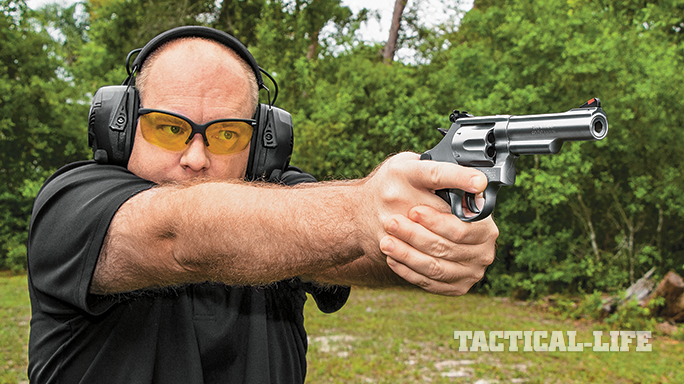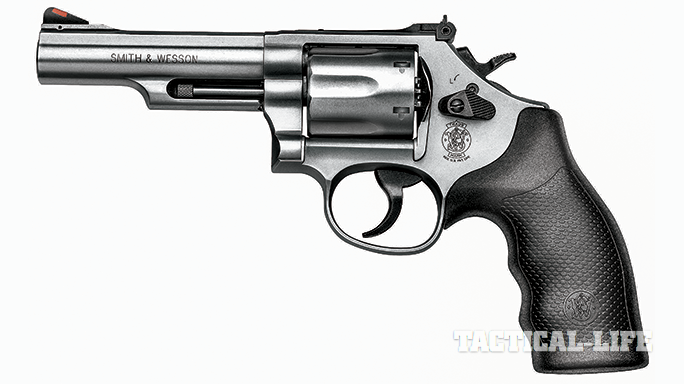People love the classics. That is one reason why Ford and GM both sell modern sports cars with stylings that harken back the height of the muscle car.
Yet, people have very emotional attachments to the original product. Create a spectacular new version of an old item and the public will love it. Do it wrong and you’ll wind up with an embarrassing albatross hung around your neck.
- RELATED STORY: Smith & Wesson’s Model 66 Combat Magnum Returns
Smith & Wesson is very well known for its revolvers. Many of its wheelgun designs are considered classics and beloved by collectors and shooters alike. Unfortunately, with the rise of the modern autoloading pistol, the revolver has taken a back seat in handgun sales. Consequently, some of the classic designs have been discontinued over the years.
Advertisement — Continue Reading Below
Nearly 10 years after the gun was dropped from the company catalog, Smith & Wesson has reintroduced the Model 66. Though it bears the same name as the original, it is not an exact duplicate of the original gun. Will shooters embrace the modern revolver or eschew it as a poorly executed copy?
REVIVED .357
Smith & Wesson introduced the first Model 66 in 1970. Labeled as a “combat magnum,” the revolver was chambered for the potent .357 Mag. The new gun was very similar to the popular Model 19, though with a stainless steel frame instead of one made of carbon steel. The Model 19 remained a hot ticket with shooters and police departments, but the Model 66 gained its own following of enthusiasts and law enforcement agencies.
Advertisement — Continue Reading Below
Various changes to the design took place over the years, several significant enough to warrant a model number update. These updated versions are designated on the gun’s frame with a hyphen and number. For example, the first engineering update designated the gun as Model 66-1. The newly released revolver is a Model 66-8, indicating the eighth major revision.
The new Model 66 has a stainless steel frame and cylinder with a two-piece barrel. The two-piece barrel combines an inner barrel with a shroud. According to Grant Cunningham, accomplished gunsmith and firearms trainer, “The system can, if properly engineered, tension the barrel and achieve a slight gain in precision.” The two-piece barrel can also reduce the labor and material costs in gun manufacturing. Less-expensive alloys can be used for the shroud since it is not subjected to the same punishment that the inner portion of the barrel is.
- RELATED STORY: 10 Reasons Why You Should Own a Revolver
“A very big reduction in cost is the elimination of the very expensive procedure of timing the barrel, getting it perfectly aligned with the rear sight, which requires a lot of hand work,” said Cunningham. “The shroud is indexed to the frame…and the barrel is simply screwed in. This reduces assembly time and the skilled labor needed to index the barrel.”
Advertisement — Continue Reading Below
A glass bead finish gives the gun a matte stainless appearance. The trigger, cylinder release, sights and hammer are all finished in black, creating a nice two-tone look.
At the time of this writing, only one barrel length is available on the Model 66: 4.25 inches. I’ve always liked 4-inch revolvers, and the extra quarter-inch does not bother me a bit. Only time will tell if Smith &Wesson will introduce other barrel lengths. Personally, I would like to see this gun with a 2.5-inch barrel for concealed carry.
Unlike earlier versions of the Model 66, the new gun has a round-butt frame. Square-butt frames were common on the guns until about 1995. Synthetic grips are also standard on the new revolvers. While not as attractive as the classic wood stocks with the S&W emblem, they are well made. A slight amount of excess rubber was visible around the seams of my test gun. The excess did not impact comfort or shooting, but I would carefully remove it from my own gun to improve the look. Even better, originally styled wood stocks would be a nice option for the handgun.
Advertisement — Continue Reading Below
I’ve always felt that the K-Frame revolvers balance very well in my hand. I own several, including a Model 10 and Model 64. When the new Model 66 arrived, it immediately felt like an old friend. A little muzzle heavy, the gun still points very well. When shooting a .357 Mag, a heavy barrel is not necessarily a bad thing. The extra weight can help reduce muzzle flip.
RANGE MASTER
There is a certain amount of satisfaction to be had when going to a public range with a fire-breathing magnum and making the plastic pistol crowd stop and take notice. I own, shoot and carry semi-automatic pistols, but I am a bit nostalgic when it comes to duty-sized revolvers. Making a little noise with one will often start a few conversations with old hands and new shooters alike. I took the Model 66 on several range trips, and every one of them sparked a conversation about the gun.
Advertisement — Continue Reading Below
The Model 66 felt good in the hand. I wasn’t sure how much I would like the rubber grips as compared to the old-style wood stocks. However, the grips did fit well in the hand and gave a modest amount of cushion when firing full-power magnum loads. I was shooting outdoors on a warm Florida afternoon, so my hands did get a little sweaty. The rubber material helped me keep a solid hold on the revolver, and at no point did I feel the recoil was going to slip the gun from my two-handed grasp.
Accuracy was good. Shooting double-action off-hand, I was able to get sub-4-inch groups at 25 yards with a number of magnum loads. The best of the bunch was the 125-grain Remington Golden Saber where five shots went inside 3.5 inches.
Shooting .38 Special wadcutter target loads really tightened up the groups. With both Sellier & Bellot and Blazer 148-grain wadcutters, I managed 1.5-inch groups off-hand and in double-action.
Advertisement — Continue Reading Below
I doubt there are many people that would argue that .357 Mag recoil isn’t stout. That does not mean, however, that the recoil is not manageable. A solid grip on the gun combined with an aggressive stance can easily help a shooter handle the cartridge’s power.
When rapidly firing, the bright red insert in the front ramp is your friend. The insert seemingly jumps into your field of view and helps bring you right back onto target. At seven yards, a cylinder full of magnum rounds will go into center mass as quickly as I can pull the trigger.
Reliability is one of the key features of the wheelgun, and this Smith & Wesson revolver did not disappoint. Every round loaded, fired and extracted as one would hope in a revolver.
Advertisement — Continue Reading Below
MAGNUM DEFENDER
Will the reintroduced Model 66 be accepted by the shooting community? Yes, I believe it will be. The new gun looks good, and just as importantly, it shoots very well. For all but the die-hard purists, the new Model 66 will please anyone looking for a duty sized .357 Mag revolver. Even the purists will have to admit that while the gun is not an exact duplication of the original Model 66, it is well-made and fun to shoot.
“As shooting tools, I generally prefer the modern guns,” said Cunningham. “When you consider aesthetics and craftsmanship, however, the new guns don’t hold a candle to the older ones. There’s the problem: Most people can’t separate utility from all the other factors of ownership. Which would I have more pride in? An older S&W. Which would I rather take out of the box and shoot? A new one. Which one is better? It depends on one’s priorities.”
Advertisement — Continue Reading Below
For more information about the Model 66, visit smith-wesson.com or call 800-331-0852.
- RELATED STORY: Gun Review: Smith & Wesson’s M&P R8 Revolver
This article was published in the 2015 Gun Buyer’s Guide. To subscribe, please visit PersonalDefenseWorld.com/subscribe.
























